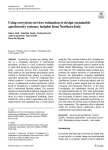Alali S., Vaglia V., Bocchi S., Schievano A., Betti M., De Marinis P. (2025). Using ecosystem services estimation to design sustainable agroforestry systems: insights from Northern Italy. Agroforestry Systems, 01/12/2025, vol. 99, n. 8, p. 257.
https://doi.org/10.1007/s10457-025-01351-0
https://doi.org/10.1007/s10457-025-01351-0
| Titre : | Using ecosystem services estimation to design sustainable agroforestry systems: insights from Northern Italy (2025) |
| Auteurs : | S. Alali ; V. Vaglia ; S. Bocchi ; A. Schievano ; M. Betti ; P. De Marinis |
| Type de document : | Article |
| Dans : | Agroforestry Systems (vol. 99, n. 8, December 2025) |
| Article en page(s) : | p. 257 |
| Langues : | Anglais |
| Langues du résumé : | Anglais |
| Catégories : |
Catégories principales 07 - ENVIRONNEMENT ; 7.4 - Ressources Naturelles : Paysage, Biodiversité, Patrimoine naturelThésaurus IAMM SERVICE ECOSYSTEMIQUE ; AGROFORESTERIE ; DURABILITE ; SCENARIO ; ITALIE |
| Résumé : | Agroforestry Systems are gaining attention as a sustainable alternative to conventional agriculture, yet there is a lack of practical methods to guide their design by integrating ex-ante participatory ecosystem services (ESs) assessment. This study addresses this gap through participatory action research in Northern Italy, aiming to co-design an innovative agroforestry system by comparing three distinct scenarios: a Successional Agroforestry System (i.e. a multilayered, evolutive agroforestry system based on biomimicry), a traditional mixed orchard, and a conventional hazelnut orchard. The research employed a mixed-method approach, engaging twelve stakeholders, including farmers, technicians, and residents, in a series of participatory workshops. Instrumental ESs, such as carbon sequestration and air pollutant removal, were quantified over a 30-year period using the i-Tree software. Intrinsic ESs, including biodiversity and cultural heritage, were assessed through an expert-based participatory process inspired by the Matrix Model Methodology. The results revealed a clear trade-off. The traditional mixed orchard demonstrated the highest provision of instrumental ES. However, the participatory evaluation highlighted the superior performance of the SAFS (Successional Agroforestry System) in delivering intrinsic and cultural ES, which is better aligned with the long-term ecological and educational objectives of the farm. Consequently, the stakeholders selected the SAFS for implementation.mail id This study demonstrates that integrating quantitative modeling with participatory assessment of intrinsic values provides a robust framework for designing sustainable agroforestry systems that reflect the holistic goals of landowners and local communities. This approach offers a replicable model for evidence-based, collaborative design of multifunctional agricultural landscapes. |
| Cote : | En ligne |
| URL / DOI : | https://doi.org/10.1007/s10457-025-01351-0 |







